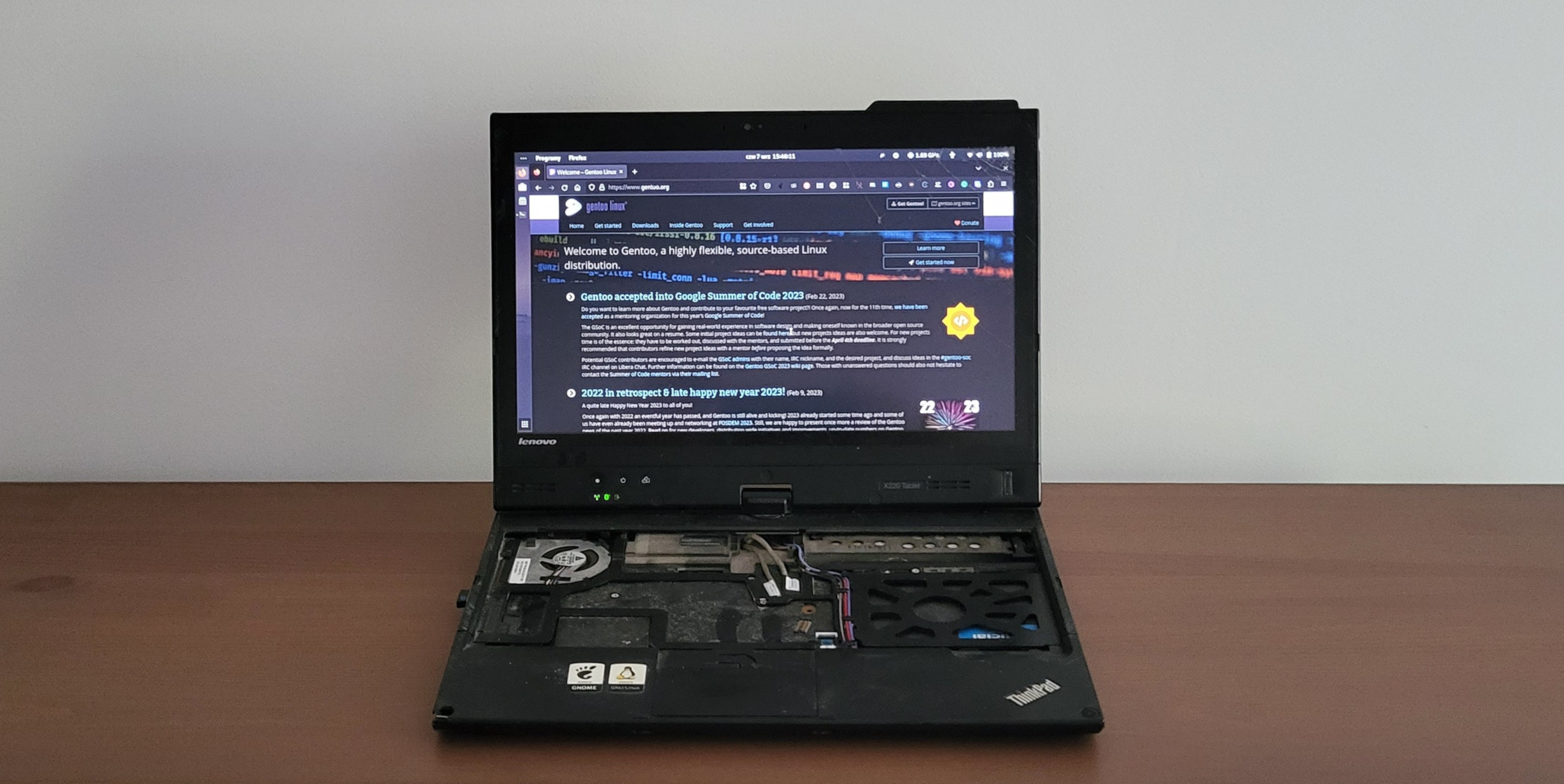This post introduces a series of articles about my experience as a self-hosted server admin. I will cover many topics, including personal history, server setup, service configuration, networking and (hopefully only a few) post-mortems.
Where it all started
I have been fascinated with technology since I can remember. When I got my first PC with Windows XP, I spent countless hours exploring all the apps and system settings. I quickly became the home IT helpdesk – whenever the printer didn’t work, or there was no space left on a disk, I was there to help (although usually not so eagerly 😜).
I need to thank my teacher for seeing potential in me, spending all this time in the classroom after hours and teaching me how things work.
From these times, I also fondly remember assisting my primary school teacher with some IT classroom issues. Be it formatting the PCs because someone loaded a surprising amount of viruses from a Pen Drive, installing Windows connected to the school’s Windows Server 2003 box, or some general network maintenance. I can say with all confidence that this was a crucial experience on the path to becoming a sysadmin. I need to thank my teacher for seeing potential in me, spending all this time in the classroom after hours and teaching me how things work.

Then, in secondary school, I was immediately picked by the IT teacher as an IT assistant due to my previous experience. I helped him with school network issues and maintained the school website hosted on a Windows Server box hidden somewhere in a closet with a classic ISS setup. I spent most of the computer science classes in my teacher’s office configuring a new version of PHP, installing some lovely Joomla plugins for the website or uploading photos from a recent school trip.
CentOS FTW
My next step on the sysadmin path was my first home server. I was still in secondary school when one of my friends introduced me to a new game, Minecraft. That rings a bell, doesn’t it? Honestly, I’m amazed that Minecraft is still a thriving game after all these years, with a lively community of players, creators and modders. Anyway, we needed a server to play together, and I had an itch to test my new-found Linux skills.
Use RAID and do frequent backups.
There was this old laptop that was just lying around collecting dust, so I thought I could use it as a Minecraft server. I searched the internet for what I could use as a solid server OS, and CentOS caught my attention. After a few failed tests, I finally got it working. There was this one little issue: it only worked locally. I quickly needed to learn about all sorts of network caveats and discovered for the first time what a NAT and dynamic IP is.
At last, it all worked, and I could finally enjoy an evening spent breaking and placing blocks with my friends. Everything seemed to be working just fine until, one day, I encountered my first server disk failure. As you might guess, the last backup was from a month before, and the laptop had a single 2.5" HDD. Not much could have been salvaged. Here, I learned the first and the most important lesson for a sysadmin-to-be: use RAID and do frequent backups.
Later, I got increasingly invested in self-hosting. At first, it was some dodgy Joomla blog for my YouTube channel, then came ownCloud, and all the fun began. I had a great urge to make the services more reliable, so the natural next step was going from on-premises to the cloud. That was when I decided to dedicate a part of my monthly allowance for my first VPS. I remember the addictive feeling of pure joy when I took care of a server, and it all simply worked, no matter the internet connection or power outages, all accessible from the internet.
Gentoo – NOT a server OS
If it works on a desktop, it may very well not be the best choice for a server.
In high school, I got fascinated with Gentoo (similar to my current passion for NixOS – I hope it will end better 😅). First, I installed it on my 4-core Lenovo X230t (poor thing) and regularly fried it with chromium builds (96 ℃ overnight – it’s a miracle it still works). Gentoo compelled me because it promised perfect configurability, optimization, and the ability to tailor the system as you see fit. It was an ideal learning experience, and I cannot overstate its importance for my Linux skill development. The only problem was that I came up with this awful idea that if it works for a desktop, it will surely work for a server.

You might already know where the story goes, but if not, let me enlighten you. Gentoo is a rolling distro (no releases, always fresh software) with a rather complicated dependency system. Long story short, when something breaks, it breaks with a flash. I recall the immeasurable amount of time I spent trying to fix a dependency issue on a half-working remote headless server with a broken glibc just when (or worse, someone else) needed the services the most.
That was certainly fun, but it was fun only because I had time for it and nothing mission-critical was hosted there. When I’m thinking about it today, I wonder how I and the data survived it and why I came so late to the second most important lesson for a sysadmin: If it works on a desktop, it may very well not be the best choice for a server. The day I finally concluded that I was tired of dealing with dependency hells and build errors, I thought it was time for a change.
The days of bliss
I needed my server to simply work and yearned to concentrate on the services, not on a constant struggle to install a new package that conflicted with another in a thousand different ways. I recalled how blissful were the days of CentOS, and I thought to myself that I needed that back. I really craved the peace and comfort of RHEL-like distro. But it wasn’t all sunshine and roses. When I tried the good ol’ CentOS after Gentoo, I realized I grew very fond of Gentoo’s fresh software. I had to seek alternatives. After some back and forth, I decided to go the Fedora way.
It was delightful. Fedora has a vast software ecosystem, frequent releases with
fresh apps and an existing alternative repository collection (be it RPM Fusion
or COPR). Still, it is reliable and maintainable, so I wasn’t worried about
breaking my system with the wrong set of USE flags. Going with Fedora was a
choice of convenience and pragmatism. I started having less time to take care of
the server and wanted to concentrate on maintaining a good experience for people
using the services.
Sometimes, it’s cheaper to pay for SaaS than to spend time trying to make a self-hosted setup work.
That was also when I engaged in what would become SENT Technology company, and I started maintaining its on-prem self-hosted cloud services (file storage, chat, GitLab and more). I went all-in with Docker, learned a lot about cloud-native technologies (including Kubernetes) and started to invest in Ansible to have the server more declaratively defined. On the other side, I would say that at one point, I overdid it and tried to self-host everything. It generated an increasing maintenance burden for me at times when I should have concentrated more on the business than on the self-hosting for the sake of self-hosting. That’s a sysadmin lesson number three: Sometimes, it’s cheaper to pay for SaaS than to spend time trying to make a self-hosted setup work.
Going stable
Unfortunately, I had to withdraw from SENT Technology. I moved professionally towards FPGA and embedded development, and because of the shifted focus, I needed to optimize my server to require even less maintenance. I resigned from a few extra self-hosted services and, in general, shrank the setup. What was left was mainly a Nextcloud and private GitLab instance running under Docker on a stable Fedora Server instance.
While my current server configuration is satisfactory, there is always room for improvement – optimizing the setup and increasing its resilience is essential. Recently, I went through a busy period where I had a lot on my plate, and it made me reconsider how I want to host the services that my loved ones and I use. It is crucial to me that we have access to reliable and secure options with as little maintenance burden as possible.
Flakes on the horizon

I heard about NixOS first in one of the Jupiter Broadcasting podcasts – LINUX Unplugged. The hosts advertised it as a flexible yet stable semi-rolling distro with a fully declarative configuration. Now, as you came to know my sysadmin background, you can probably imagine how that appealed to me and my needs. I didn’t participate in the NixOS challenge organized by JB, but I stayed in the loop and cautiously, yet with keen interest, entertained the idea of giving the distro a try.
First, I deployed a tiny VM providing Tailscale VPN access to some of my intranet services. It all suddenly clicked. I got hooked from the start. I suddenly realized that this is precisely how I want to run my servers. Now, it is only a matter of one big experiment and (hopefully) one last migration.
The big experiment
The big experiment I’m talking about is a backup server. You might think I’ve learned nothing, and I most definitely shouldn’t perform experiments on anything touching backups. Let’s say it is a backup backup server I’m talking about 😉
I must be brutally honest with myself: I need to take backups more seriously. Currently, I have a working solution, but it’s built from a set of self-written scripts, lacking in areas of automatic redundancy and verification. It’s alright, but could be better. I undoubtedly consider it the most significant shortcoming in my entire self-hosted workflow.
As for achieving inner peace with backups, I intend to have a separate server cut off from the internet. Its sole purpose will be ensuring that all my servers are fully backed up and performing a suite of automatic integrity checks, pruning, and replication. All this will be built on a solid, maintainable base of NixOS.
Summary
I am thrilled to share my journey as a self-hosted server admin through a series of blog posts. Over the years, I have maintained various systems, including school networks, a gaming server and a small business on-prem cloud services. I have experimented with different distros like CentOS, Gentoo, and Ubuntu before finally settling on Fedora. Through my journey, I have learned valuable lessons I want to share with aspiring sysadmins. The three pieces of advice I’d like you to remember may not be much. Still, they go very deep into my experience as a self-taught sysadmin and will be helpful if you’re a seasoned SysOp or just starting your journey.
So here are the three points you should remember:
- Use RAID and do frequent backups.
- If it works on a desktop, it may very well not be the best choice for a server.
- Sometimes, it’s cheaper to pay for SaaS than to spend time trying to make a self-hosted setup work.
As for what the future holds, stay tuned for the blog post series, where I’ll share my experience with NixOS, a flexible and stable semi-rolling distro with a fully declarative configuration. I plan to discuss in detail the unique value of NixOS, my reasons for choosing it, and, finally, my endeavour of creating a perfect NixOS-based backup server. See you soon 👋
Images marked with “DALL·E” are generated using Bing Create which internally uses DALL·E AI for image generation. The prompt used to generate the image is written in quotes.
